Evaluation of Ultrasonic Vibration-Assisted Grinding in Multi-Process Profile Grinding of K4002 Nickel-Based Superalloy Blade Tenons
Abstract
1. Introduction
2. Experimental Details
2.1. Experimental Device
2.2. Experimental Process
2.3. Test Method
3. Results and Discussion
3.1. Intermittent Cutting Behavior in UVG
3.1.1. Theoretical Modeling of Intermittent Cutting
3.1.2. Evaluation of Intermittent Cutting
3.2. Grinding Force
3.3. Grinding Temperature
3.4. Workpiece Surface Integrity
3.4.1. Workpiece Surface Topography
3.4.2. Workpiece Surface Roughness
4. Conclusions
- The ultrasonic vibration causes intermittent cutting behaviors in the grinding, resulting in the decrease in contact rate to 0.6 at most. The contact rate decreases with the increase in the grinding process, indicating that the effect of intermittent cutting is more significant under the condition of a large material removal rate.
- For the profile grinding of the blade tenon, the maximum grinding force occurs at the start of the full contact stage. The percentage of the force reduction is negatively correlated with the contact rate in UVG. The grinding force can be reduced by more than 20% on average by the ultrasonic vibration.
- The grinding temperature varies greatly from larger than 900 °C to below 100 °C throughout the whole machining process of the blade tenon. The ultrasonic vibration assistance can reduce the grinding temperature by 23% on average.
- For the profile grinding of the blade tenon, the middle top area of the blade tenon has the highest grinding temperature and is most easily burned out. UVG can improve the surface burnout of the blade tenon. The differences of surface topographies and roughness between CG and UVG are inapparent in the fine grinding process because of the large contact rate in UVG under the condition of a small material removal rate.
Author Contributions
Funding
Institutional Review Board Statement
Informed Consent Statement
Data Availability Statement
Conflicts of Interest
References
- Zhang, B.; Wu, S.; Wang, D.; Yang, S.; Jiang, F.; Li, C. A review of surface quality control technology for robotic abrasive belt grinding of aero-engine blades. Measurement 2023, 220, 113381. [Google Scholar] [CrossRef]
- Li, X.; Qin, B.; Wang, Z.; Zhang, Y.; Yu, J. Grinding of fir tree slots of powder metallurgy superalloy FGH96 using profiled electroplated CBN wheel. Int. J. Adv. Manuf. Technol. 2021, 115, 311–317. [Google Scholar] [CrossRef]
- Miao, Q.; Ding, W.; Xu, J.; Cao, Z.; Wang, H.; Yin, Z.; Dai, C.; Kuang, W. Creep feed grinding induced gradient microstructures in the superficial layer of turbine blade root of single crystal nickel-based superalloy. Int. J. Extrem. Manuf. 2021, 3, 045102. [Google Scholar] [CrossRef]
- Lukas, Z.; Robert, B. Dressing process in the grinding of aerospace blade root. J. Mech. Sci. Technol. 2007, 31, 4411–4417. [Google Scholar]
- Song, Y.; Shi, K.; He, Z.; Wang, S.; Zhang, Z.; Shi, Y.; Huai, W. Wear characteristics evolution of corundum wheel and its influence on performance in creep feed grinding of nickel-based superalloy. Wear 2025, 562–563, 205649. [Google Scholar] [CrossRef]
- Grimmert, A.; Pachnek, F.; Wiederkehr, P. Temperature modeling of creep-feed grinding processes for nickel-based superalloys with variable heat flux distribution. CIRP J. Manuf. Sci. Technol. 2023, 41, 477–489. [Google Scholar] [CrossRef]
- Singh, A.; Sharma, V. Sustainable grinding approach to analyze surface integrity of nickel-based superalloy using atomized green cutting fluid. J. Manuf. Process. 2023, 102, 1023–1042. [Google Scholar] [CrossRef]
- Schieber, C.; Hettig, M.; Zaeh, M.; Heinzel, C. Evaluation of approaches to compensate the thermo-mechanical distortion effects during profile grinding. Procedia CIRP 2021, 102, 331–336. [Google Scholar] [CrossRef]
- Yang, S.; Chen, W.; Nong, S.; Dong, L.; Yu, H. Temperature field modelling in the form grinding of involute gear based on high-order function moving heat source. J. Manuf. Process. 2022, 81, 1028–1039. [Google Scholar] [CrossRef]
- Grimmert, A.; Wiederkehr, P. Macroscopic process simulation of surface and profile grinding processes estimating forces for the production of turbine blades. Procedia CIRP 2021, 102, 126–131. [Google Scholar] [CrossRef]
- Li, B.; Ding, W.; Zhu, Y.; Li, C.; Ma, X.; Yang, M.; Zhang, Y.; Liu, M.; Cui, X. Thermal analysis on profile grinding of turbine disc slots of powder metallurgy superalloy FGH96. Int. Commun. Heat Mass Transf. 2024, 159, 108207. [Google Scholar] [CrossRef]
- Yin, Y.; Xu, J.; Shi, L.; Guo, G.; Zhu, X.; Meng, Y.; Ming, W.; Chen, M. Study on thermal damage formation mechanisms and surface integrity in creep-feed profile grinding of superalloys. J. Manuf. Process. 2024, 120, 28–50. [Google Scholar] [CrossRef]
- Li, G.; Chen, F.; Bie, W.; Zhao, B.; Fu, Z.; Wang, X. Cavitation effect in ultrasonic-assisted electrolytic in-process dressing grinding of nanocomposite ceramics. Materials 2021, 14, 5611. [Google Scholar] [CrossRef]
- Zhao, B.; You, H.; Miao, Q.; Ding, W.; Qian, N.; Xu, J. Surface integrity characterization of third generation nickel-based single crystal blade tenons after ultrasonic vibration-assisted grinding. Chin. J. Aeronaut. 2025, 38, 103138. [Google Scholar] [CrossRef]
- Zhao, B.; Wang, X.; Chen, T.; Ding, W.; Qian, N.; Xu, J. Simulation and experimental thermal analysis of ultrasonic vibration-assisted high-efficiency deep grinding of γ-TiAl blade tenon. Appl. Therm. Eng. 2025, 258, 124629. [Google Scholar] [CrossRef]
- Miao, Q.; Ding, W.; Chen, T.; Zhao, B.; Qian, N.; Dai, C.; Yin, Z. Surface gradient structures in single-crystal nickel alloy induced by ultrasonic-assisted high-speed grinding. Mater. Today Commun. 2024, 38, 107930. [Google Scholar] [CrossRef]
- Zhou, W.; Tang, J.; Shao, W.; Wen, J. Towards understanding the ploughing friction mechanism in ultrasonic assisted grinding with single grain. Int. J. Mech. Sci. 2022, 222, 107248. [Google Scholar] [CrossRef]
- Naskar, A.; Choudhary, A.; Paul, S. Surface generation in ultrasonic-assisted high-speed superabrasive grinding under minimum quantity cooling lubrication with various fluids. Tribol. Int. 2021, 156, 106815. [Google Scholar] [CrossRef]
- Li, G.; Kang, R.; Wang, H.; Bao, Y.; Wang, Y. Undeformed chip thickness models for precise vertical—Spindle face grinding of tungsten heavy alloy. Precis. Eng. 2024, 88, 970–985. [Google Scholar] [CrossRef]
- Zhang, K.; Dai, C.; Yin, Z.; Miao, Q.; Chen, J.; Chen, Q.; Yang, S. Modeling and prediction on grinding force in ultrasonic assisted elliptical vibration grinding (UAEVG) of SiC ceramics using single diamond grain. J. Manuf. Process. 2024, 131, 2244–2254. [Google Scholar] [CrossRef]
- Chen, Y.; Su, H.; He, J.; Qian, N.; Gu, J.; Xu, J.; Ding, K. The effect of torsional vibration in longitudinal-torsional coupled ultrasonic vibration assisted grinding of silicon carbide ceramics. Materials 2021, 14, 688. [Google Scholar] [CrossRef] [PubMed]
- Cao, Y.; Zhao, B.; Ding, W.; Jia, X.; Wu, B.; Liu, F.; Zhu, Y.; Liu, Q.; Xu, D. Evolution of undeformed chip thickness and grinding forces in grinding of K4002 nickel-based superalloy using corundum abrasive wheel. Chin. J. Aeronaut. 2025, 38, 102937. [Google Scholar] [CrossRef]
- Jamshidi, H.; Budak, E. An analytical grinding force model based on individual grit interaction. J. Mater. Process. Technol. 2020, 283, 116700. [Google Scholar] [CrossRef]
- Liu, M.; Li, C.; Zhang, Y.; Yang, M.; Gao, T.; Cui, X.; Wang, X.; Xu, W.; Zhou, Z.; Liu, B.; et al. Analysis of grinding mechanics and improved grinding force model based on randomized grain geometric characteristics. Chin. J. Aeronaut. 2023, 36, 160–193. [Google Scholar] [CrossRef]
- Li, D.; Tang, J.; Chen, H.; Shao, W. Study on grinding force model in ultrasonic vibration-assisted grinding of alloy structural steel. Int. J. Adv. Manuf. Technol. 2019, 101, 1467–1479. [Google Scholar] [CrossRef]
- Wu, H.; Yao, Z. Force modeling for 2D freeform grinding with infinitesimal method. J. Manuf. Process 2021, 70, 108–120. [Google Scholar] [CrossRef]
- Zhang, D.; Chen, T.; Suo, H.; Zhang, C.; Liu, F. A grinding force prediction model and experimental validation for ultrasonic-assisted end grinding of 2.5D C/SiC composites. Measurement 2025, 242, 116118. [Google Scholar]
- Cao, Y.; Zhao, B.; Ding, W.; Huang, Q. Vibration characteristics and machining performance of a novel perforated ultrasonic vibration platform in the grinding of particulate-reinforced titanium matrix composites. Front. Mech. Eng. 2023, 18, 14. [Google Scholar] [CrossRef]
- Wen, J.; Tang, J.; Zhou, W. Study on formation mechanism and regularity of residual stress in ultrasonic vibration grinding of high strength alloy steel. J. Manuf. Process. 2021, 66, 608–622. [Google Scholar] [CrossRef]
- Zhou, W.; Tang, J.; Shao, W. Modelling of surface texture and parameters matching considering the interaction of multiple rotation cycles in ultrasonic assisted grinding. Int. J. Mech. Sci. 2020, 166, 105246. [Google Scholar] [CrossRef]
- Yang, Z.; Zhu, L.; Lin, B.; Zhang, G.; Ni, C.; Sui, T. The grinding force modeling and experimental study of ZrO2 ceramic materials in ultrasonic vibration assisted grinding. Ceram. Int. 2019, 45, 8873–8889. [Google Scholar] [CrossRef]
- Yue, Y.; Zhao, B.; Wu, B.; Ding, W. Undeformed chip thickness and machined surface roughness in radial ultrasonic vibration-assisted grinding process. Int. J. Adv. Manuf. Technol. 2022, 12, 299–311. [Google Scholar] [CrossRef]
- Lu, S.; Gao, H.; Bao, Y.; Xu, Q. A model for force prediction in grinding holes of SiCp/Al composites. Int. J. Mech. Sci. 2019, 160, 1–14. [Google Scholar] [CrossRef]
- Wang, H.; Pei, Z.; Cong, W. A mechanistic cutting force model based on ductile and brittle fracture material removal modes for edge surface grinding of CFRP composites using rotary ultrasonic machining. Int. J. Mech. Sci. 2020, 176, 105551. [Google Scholar] [CrossRef]
- Wang, Z.; Bao, Y.; Feng, K.; Li, B.; Dong, Z.; Kang, R.; Wang, Y. Characterization, quantitative evaluation, and formation mechanism of surface damage in ultrasonic vibration assisted scratching of Cf/SiC composites. J. Eur. Ceram. Soc. 2024, 44, 4502–4523. [Google Scholar] [CrossRef]


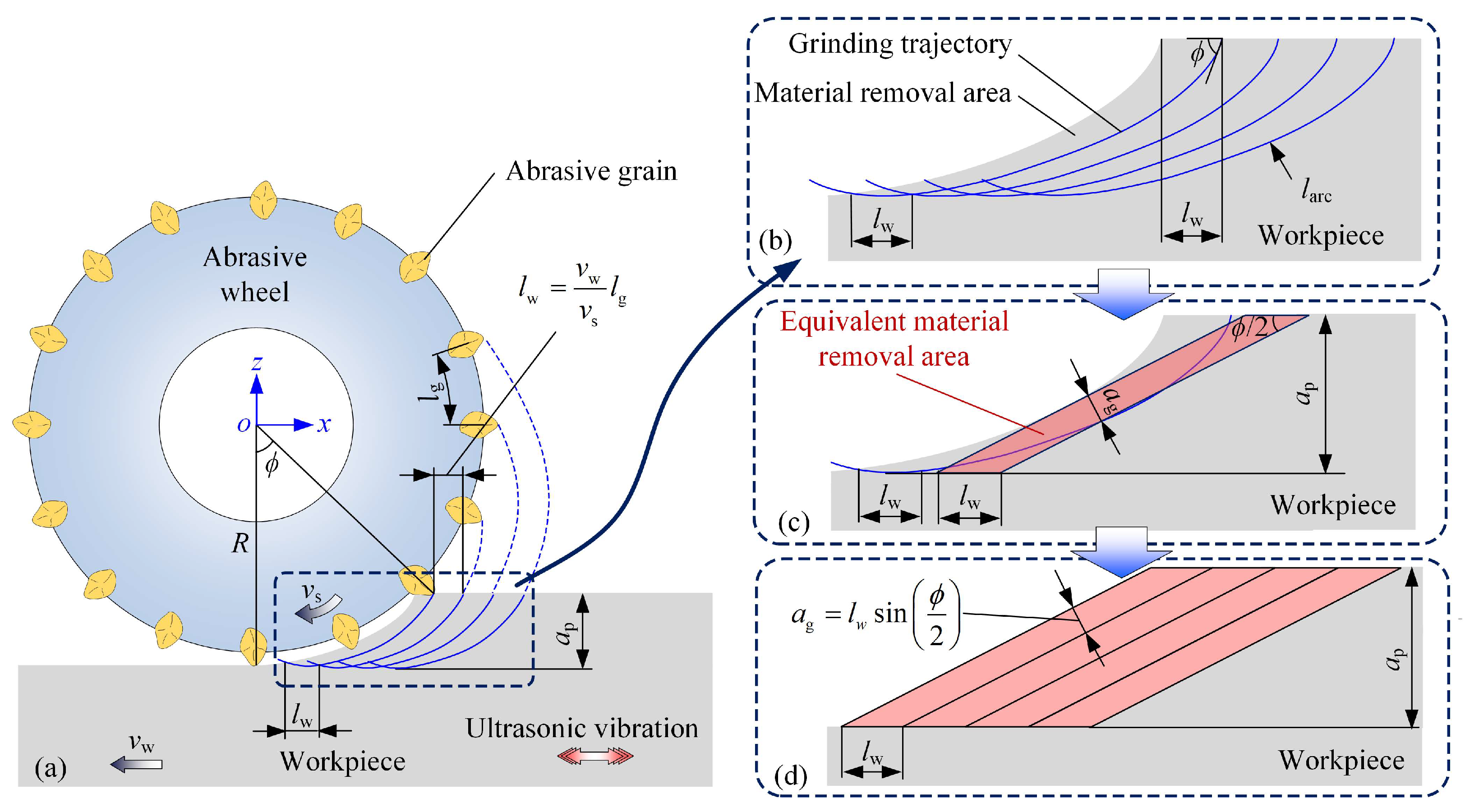

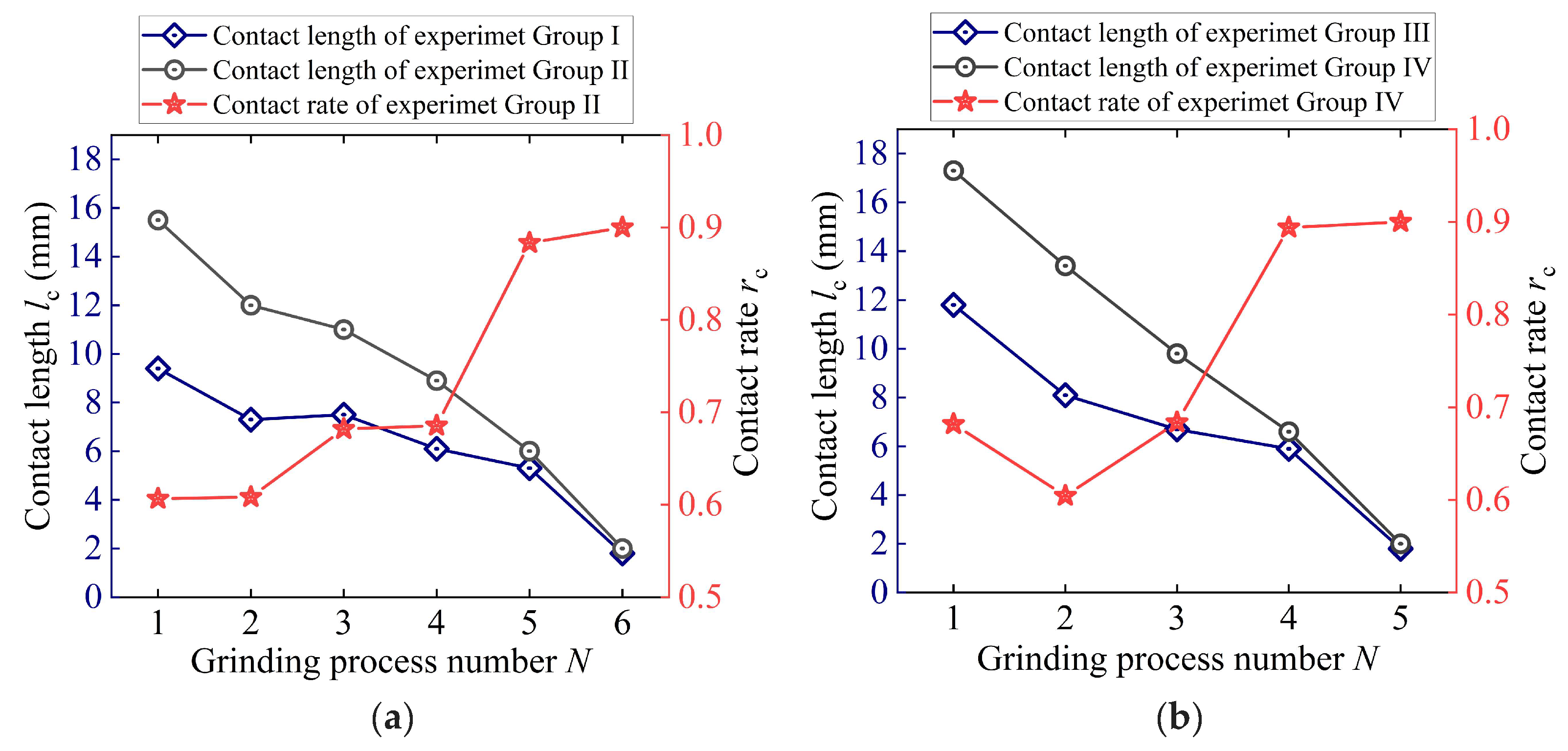
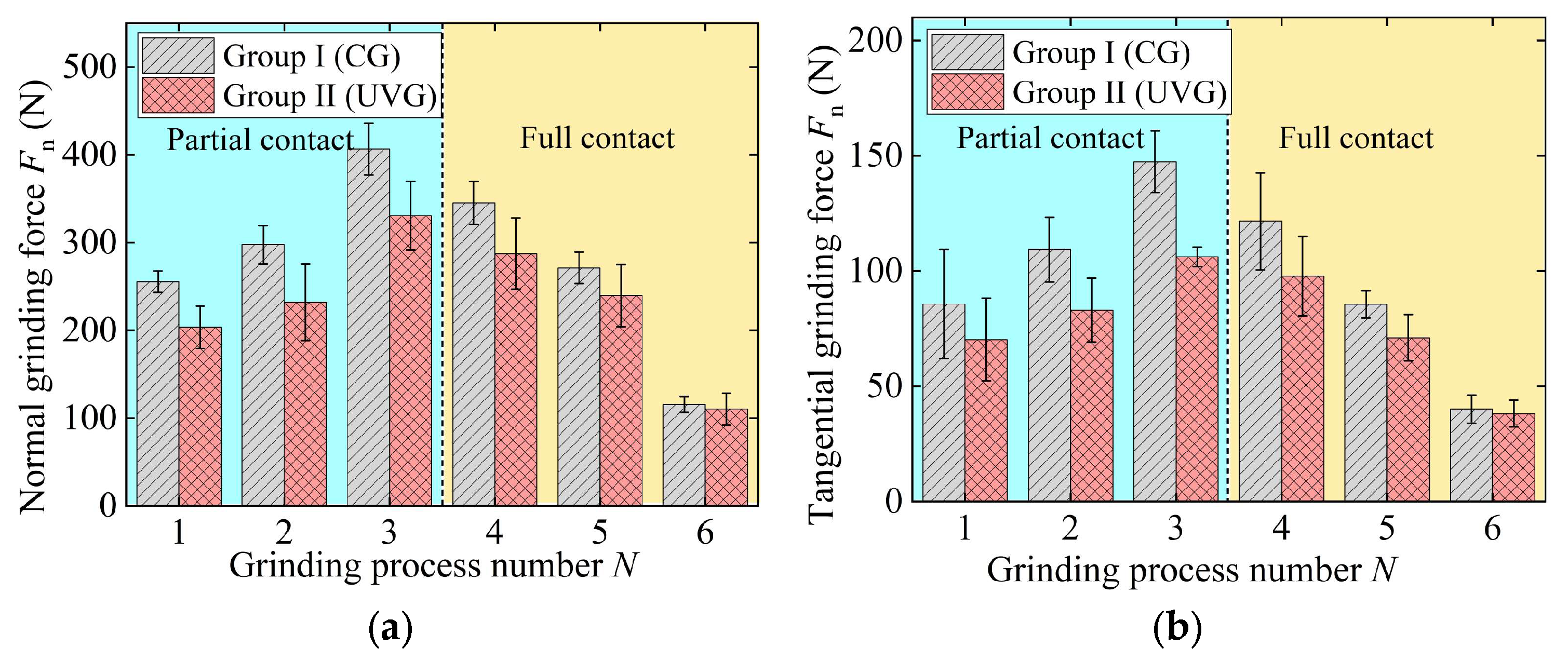



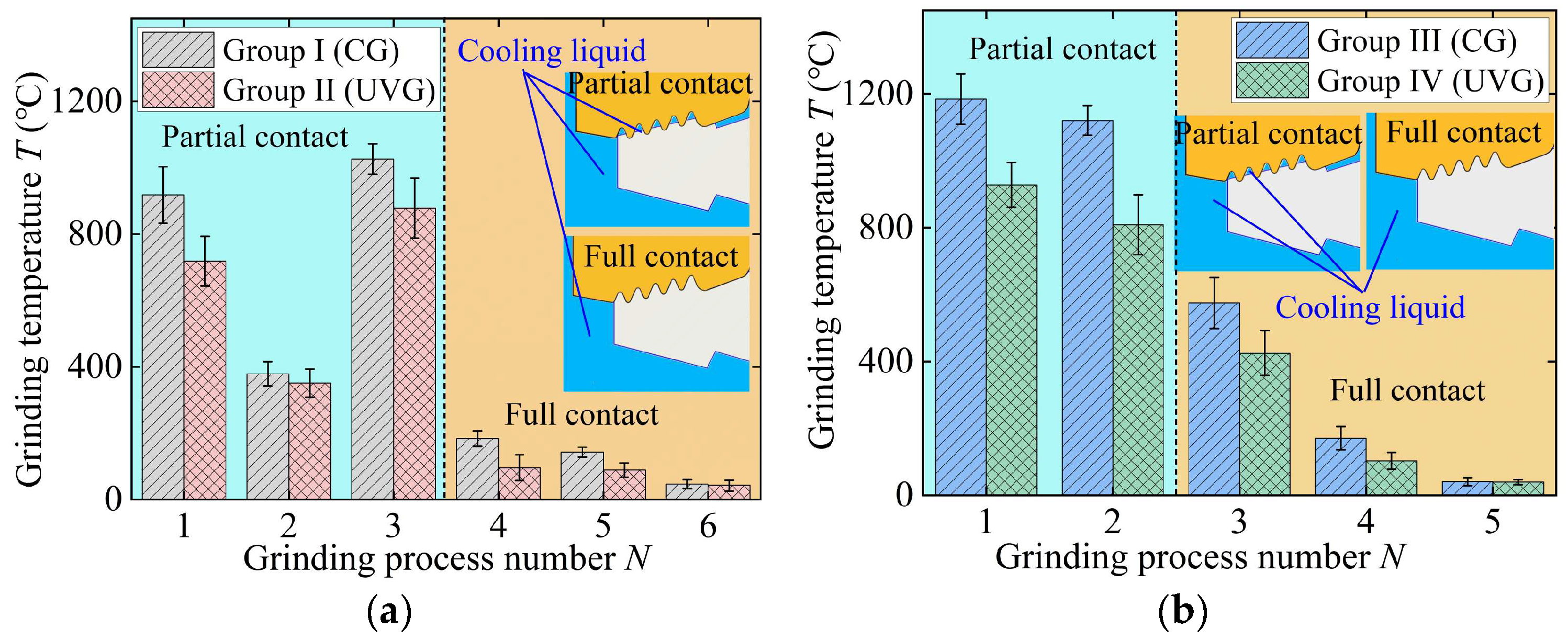



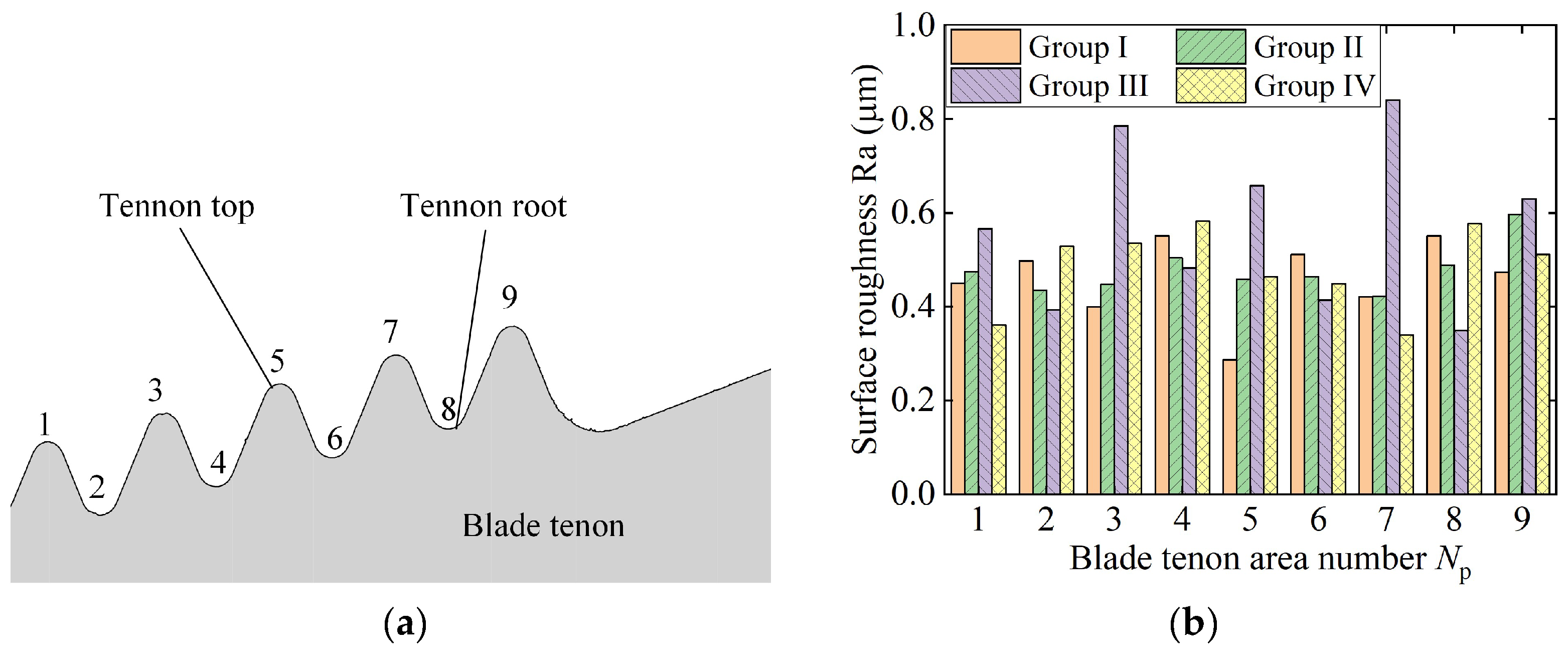
| Grinding Condition | Parameter |
|---|---|
| Machine | 3-axis profile grinder (Smart BD10, ELB, Germany) |
| Mode | Down grinding |
| Abrasive wheel | Corundum and white corundum mixed abrasive grinding wheel (WA/PA80/100F8V35m/sCF3) |
| Workpiece | K4002 nickel-based superalloy fir-tree blade tenon |
| Ultrasonic vibration | |
| Wheel dressing | |
| Cooling medium | 5% water-based emulsion (Syntilo 9954, Castro, UK) |
| Grinding Process Number | Grinding Speed vs (m/s) | Workpiece Infeed Speed vw (mm/min) | Grinding Depth ap (mm) | Ultrasonic Amplitude A (μm) | |
|---|---|---|---|---|---|
| Group I | Group II | ||||
| 1 | 20 | 150 | 0.60 | 0 | 5 |
| 2 | 20 | 150 | 0.36 | 0 | 5 |
| Abrasive wheel dressing | |||||
| 3 | 20 | 200 | 0.30 | 0 | 5 |
| 4 | 20 | 200 | 0.20 | 0 | 5 |
| 5 | 20 | 300 | 0.09 | 0 | 5 |
| Abrasive wheel dressing | |||||
| 6 | 20 | 300 | 0.01 | 0 | 5 |
| Grinding Process Number | Grinding Speed vs (m/s) | Workpiece Infeed Speed vw (mm/min) | Grinding Depth ap (mm) | Ultrasonic Amplitude A (μm) | |
|---|---|---|---|---|---|
| Group III | Group IV | ||||
| 1 | 15 | 150 | 0.75 | 0 | 5 |
| 2 | 20 | 150 | 0.45 | 0 | 5 |
| 3 | 20 | 200 | 0.24 | 0 | 5 |
| 4 | 20 | 300 | 0.11 | 0 | 5 |
| Abrasive wheel dressing | |||||
| 5 | 20 | 300 | 0.01 | 0 | 5 |
Disclaimer/Publisher’s Note: The statements, opinions and data contained in all publications are solely those of the individual author(s) and contributor(s) and not of MDPI and/or the editor(s). MDPI and/or the editor(s) disclaim responsibility for any injury to people or property resulting from any ideas, methods, instructions or products referred to in the content. |
© 2025 by the authors. Licensee MDPI, Basel, Switzerland. This article is an open access article distributed under the terms and conditions of the Creative Commons Attribution (CC BY) license (https://creativecommons.org/licenses/by/4.0/).
Share and Cite
Cao, Y.; He, Y.; Liu, F.; Li, B.; Li, Z.; Guo, X.; Lv, Z. Evaluation of Ultrasonic Vibration-Assisted Grinding in Multi-Process Profile Grinding of K4002 Nickel-Based Superalloy Blade Tenons. Materials 2025, 18, 1437. https://doi.org/10.3390/ma18071437
Cao Y, He Y, Liu F, Li B, Li Z, Guo X, Lv Z. Evaluation of Ultrasonic Vibration-Assisted Grinding in Multi-Process Profile Grinding of K4002 Nickel-Based Superalloy Blade Tenons. Materials. 2025; 18(7):1437. https://doi.org/10.3390/ma18071437
Chicago/Turabian StyleCao, Yang, Yun He, Fei Liu, Benkai Li, Zheng Li, Xiaobo Guo, and Zhangquan Lv. 2025. "Evaluation of Ultrasonic Vibration-Assisted Grinding in Multi-Process Profile Grinding of K4002 Nickel-Based Superalloy Blade Tenons" Materials 18, no. 7: 1437. https://doi.org/10.3390/ma18071437
APA StyleCao, Y., He, Y., Liu, F., Li, B., Li, Z., Guo, X., & Lv, Z. (2025). Evaluation of Ultrasonic Vibration-Assisted Grinding in Multi-Process Profile Grinding of K4002 Nickel-Based Superalloy Blade Tenons. Materials, 18(7), 1437. https://doi.org/10.3390/ma18071437






